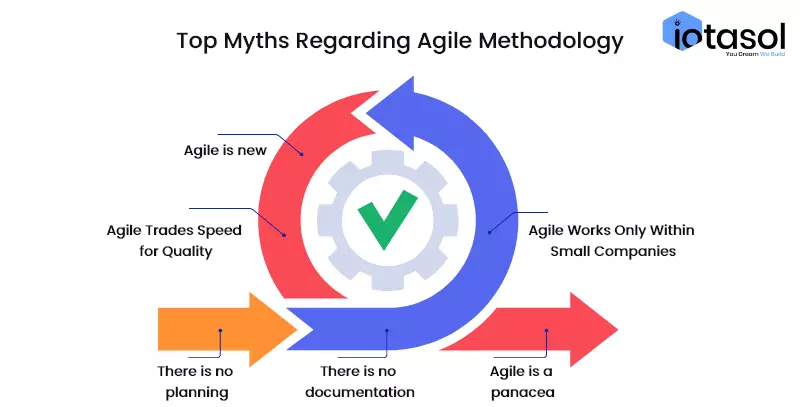Introduction
Being a practitioner of agile methodology for software development for quite some years now, we, as an organization and as a team, come across many doubts and misconceptions that new team members or managers have regarding various aspects of agile.
We call these misconceptions ‘myths’ that either stem from partial understanding or lack of clarity of the nature of agile.
Through this article, we are going to debunk the most common myths related to agile development along with sharing proper reasoning so that you have an overall better understanding of agile by the end of this read.
Before we jump on to myths, Lets first understand What is Agile
What is Agile?
Agile is a project management approach in which the project is delivered in small iterations rather than providing one big launch of the entire project. A set of principles is followed while following agile. Small iterations make an important part of agile. Time-to-time feedback and improvements are important aspects of Agile methodology so that the final output looks like what the client asked for.
Here are the top myths related to Agile methodology
Top myths regarding agile methodology
a. There is no planning
Many people believe that there is no planning in agile which is completely wrong. Since Agile is a dynamic model of work where small iterations are followed to accomplish a part of the project, review it, and accordingly set the next course of action, there is no static planning but there is intensive iterative planning involved in Agile.
By iterative planning, we mean the plan undergoes adjustment multiple times as per the feedback and analysis. The idea is to plan at the most suitable time and make changes in the execution phase if need be.
b. There is no documentation
Most people tend to misinterpret a line in the Agile Manifesto that states, “We value working software over comprehensive documentation”. It becomes important to realize that this does not deny that documentation is not required, rather, the message is that the focus should be on creating a proper function software rather than spending too much time on the documentation.
Also, documentation has integral importance for any business to be able to utilize the software product optimally and for their technical teams to maintain it. Any software delivery will be considered more of technical debt or an incomplete delivery without providing value-driven and beneficial project documentation.
c. Agile is a panacea
Agile is not a panacea. It does not hold answers to all IT problems. No framework can act as a one-stop solution rather it is about integrating different frameworks and using them to solve a part of the problem.
Any framework be it agile or not, must have a pragmatic approach and should be applicable in the real world. So, the answer lies in integrating different agile or not agile frameworks to best cater to the delivery and management needs of the systems that will operate in the real world.
d. Agile is new
Another myth about agile is that it is new and immature as an approach. Well, the Agile manifesto, which we know today, officially came into being around 2 decades ago when 17 programmers got together on a ski trip and by chance had a full-fledged discussion on project management ways, which ultimately gave birth to the agile manifesto. The agile manifesto then gained popularity quickly.
However, the defining frameworks of agile methodology supposedly evolved in the 1980s and 1990s which established agile as a mature methodology.
Moreover, the very nature of agile methodology, which focuses on constant assessment and modification, is evolutionary theory's fundamental principle. This also defines the nature of human beings as well when it comes to interacting and surviving in this complex world.
So, we can say that agile has been ingrained in our lives in one way or the other since a long time. Giving it a definition and establishing proper regulations could be a part of the evolutionary process that happened later.
e. Agile suits only Small Companies
One of the prevalent myths around agile implementation is that big companies believe agile is not for them. The concept that needs to be understood here is that while agile works great when it is executed in small teams but this factor does not rule out its potential to help large organizations.
Of course, for switching from some other methodology to agile, a fair amount of preparation will be needed. You cannot just change the course of action of the entire enterprise in the speck of a moment and expect them to work perfectly well.
You also need to remember that agile is a set of principles and not just a formula. Your organization’s culture, the mindset, and willingness of your employees to adapt to this new thing as well as the leadership prowess play an important role in making it a success.
Big names like Spotify and Microsoft use Agile and have been able to experience breakthrough success by implementing agile in small batches.
Spotify solved great problems using Agile methodology and achieved mind-boggling success through innovation like ‘Discover Weekly’, that not only helped them satisfy their current users but also win them millions of new users. Now, ‘ Discover weekly’ was just one of the hundreds of small teams in Spotify that used agile methodology and got the work done without any need to conduct extensive ROI analyses.
This way, large organizations can adopt Agile in small batches and conduct analysis on feedback and adjust accordingly in the next implementation batch.
f. Agile compromises quality for speed
People tend to believe that the speed and productivity offered by Agile lead to a compromise on quality. Also, some believe that agile does not offer dedicated quality assurance.
But, if the proponents of this belief have a close look at the agile workflow, they will be able to see that quality checks and testing stay an integral part of the workflow and are carried on at each step within the team.
You also need to remember that agile is a set of principles and not just a formula. Your organization’s culture, the mindset, and willingness of your employees to adapt to this new thing as well as the leadership prowess play an important role in making it a success.
Big names like Spotify and Microsoft use Agile and have been able to experience breakthrough success by implementing agile in small batches.
Conclusion
So, here we have debunked the most prominent agile myths that we keep encountering from our clients or enterprises in general. We hope that this really has provided you shed away your doubts related to Agile, if there are any other myths that you hold in your head related to agile, let us know in the comment section.
Also, if you want to take action in adopting agile for your project management, do get in touch with our growth experts to understand how iotasol can help you with fast and optimum project delivery using Agile project management.


